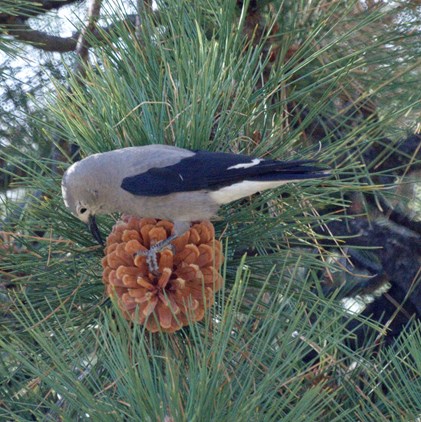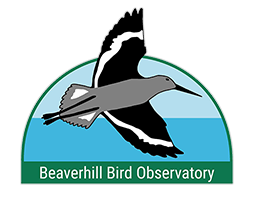Whitebark Pine and Clark's Nutcracker
Thursday, April 23, 2020Whitebark Pine is a conifer tree found throughout the mountainous regions of western North America. The Canadian Rocky Mountains constitute about 56% of the total global range of Whitebark Pine and this species is commonly found in Jasper, Banff, Kootney, Glacier, and Waterton National Park. The pine grows near the tree line in unfertile, previously unoccupied soil and turn it into fertile soil, thus paving the way for other species in the community to occupy. This process is called primary succession. Whitebark Pine is also a keystone species, i.e., without this species, the landscape would change dramatically as many species of plants and mammals depend on it. The pine seeds, for example, are very nutritious and serve as a significant diet source for various mammals, including Grizzlies, Black Bears, and Red Squirrels.
 The Clark’s Nutcracker is a greyish-black coloured bird, slightly bigger than a Blue Jay. It occupies the same habitat as the Whitebark Pine and lives in a mutual relationship with this pine, meaning both species benefit from each other. A significant part of the nutcracker’s diet consists of the nutritious Whitebark Pine seeds. The Whitebark Pine is what we call a stone pine species, i.e., unlike other pines, the cones of a Whitebark Pine do not open automatically upon seed maturation and, therefore, do not spread with wind. It needs an extractor to extract the seeds from cones and spread them - a perfect bargain for the Clark’s Nutcracker. The nutcrackers use their pointed beak to pry open the cones and harvest the seeds, then cache the seeds in various locations in the soil for later use. A single bird may cache up to 98,000 seeds in a year, as far as 30 km away from the source tree! While the nutcracker will use these cached seeds to feed their young and survive the cold winters, about half of the seeds get overlooked or forgotten and will grow into pine seedlings. However, this intricate relationship which allows both species to flourish, is at risk. Whitebark Pine is currently listed as an endangered species in Canada. In this blog, we will explore the conservation concerns faced by the Whitebark Pine and the Clark’s Nutcracker.
The Clark’s Nutcracker is a greyish-black coloured bird, slightly bigger than a Blue Jay. It occupies the same habitat as the Whitebark Pine and lives in a mutual relationship with this pine, meaning both species benefit from each other. A significant part of the nutcracker’s diet consists of the nutritious Whitebark Pine seeds. The Whitebark Pine is what we call a stone pine species, i.e., unlike other pines, the cones of a Whitebark Pine do not open automatically upon seed maturation and, therefore, do not spread with wind. It needs an extractor to extract the seeds from cones and spread them - a perfect bargain for the Clark’s Nutcracker. The nutcrackers use their pointed beak to pry open the cones and harvest the seeds, then cache the seeds in various locations in the soil for later use. A single bird may cache up to 98,000 seeds in a year, as far as 30 km away from the source tree! While the nutcracker will use these cached seeds to feed their young and survive the cold winters, about half of the seeds get overlooked or forgotten and will grow into pine seedlings. However, this intricate relationship which allows both species to flourish, is at risk. Whitebark Pine is currently listed as an endangered species in Canada. In this blog, we will explore the conservation concerns faced by the Whitebark Pine and the Clark’s Nutcracker.
Conservation Concerns for the Whitebark Pine
There are four major factors threatening the Whitebark Pine: fire suppression, White Pine Blister Rust, Mountain Pine Beetle, and climate change.
The competition of tree growth in high elevations is limited by the natural rugged environmental conditions, which provides an environmental edge for the Whitebark Pine to grow and flourish. Due to human caused fire suppression in lower elevations, however, Whitebark Pine is being outcompeted by other species, such as Engelmann Spruce and Subalpine Fir, thereby reducing their range.
White Pine Blister Rust is another problem for Whitebark Pine and it is caused by a species of fungus introduced from Eurasia back in the early 20th century. Once White Pine Blister Rust infects a Whitebark Pine tree, it forms cankers that chokes the pine’s branch stems thereby either killing or severely damaging the tree. Scientists estimate that this rust may kill up to 56% of the Whitebark Pine trees in Canada over the next 100 years.
Unlike the blister rust, Mountain Pine Beetle is actually native to North America. Pine beetles attack and kill many species of pine in western North America including Whitebark Pine. In the 20th century, western Canada regularly experienced small outbreaks of pine beetles every few years, which were followed by a slower period of inactivity. But the winter survival for the pine beetles has increased due to warmer winters caused by climate change. As a result, Mountain Pine Beetles have been spreading into the Whitebark Pine range more and more. In some stands of Whitebark Pine, like the ones in the Greater Yellowstone Ecosystem, Mountain Pine Beetles have already killed over 90% of trees. Therefore, as the pine beetles continue to spread further, it will most likely lead to increased mortality rates of Whitebark Pines in Canada.
Lastly, the growth of Whitebark Pine is also influenced by climate change. These pine likes to grow near tree line, where there is less competition from other species. With the increasingly warming temperature however, tree species like Douglas-fir, which normally cannot grow in Whitebark Pine range due to the rugged environmental conditions, will start being able to grow and outcompete these pines. As a result, the suitable habitat for Whitebark Pine is expected to shift further upslope, which may temporarily help the pines in coping with these changing conditions, but it cannot completely compensate for the lost habitat due to the limited room available upslope. Forestry models predict that by 2100, we will lose 97% of the Whitebark Pine range across western North America.
Impact on the Clark’s Nutcracker
Declining abundance of Whitebark Pine will also impact our Clark’s Nutcrackers. These nutcrackers are able to sense variation in food availability and they have the ability to modify their reproductive behaviours to accommodate these changes. This is a mechanism that normally favors species’ survival. However, one study conducted in the Greater Yellowstone Ecosystem found that in the years of low Whitebark Pine seed productivity, Clark’s Nutcrackers did not reproduce at all. Therefore, as the Whitebark Pine populations continue to decline throughout its range, it may also jeopardize the populations of Clark’s Nutcrackers that depend on their seeds as a vital food resource.
What Can We Do?
Planting a garden to reduce your carbon footprint, thereby reducing the impacts of climate change, is a great way we can help while also helping you to save money! As the summer approaches, we will all be looking for things to do outside. Planting a garden is a great way to spend some quality time outdoors. You can plant a vegetable and fruit garden, which can help you decrease your reliance on the store-bought food that often has to travel thousands of kilometers before getting on your plate, producing huge amounts of carbon emissions along the way. By growing your own local foods, you will have a significantly lower carbon footprint, which is better for climate change and for your wallet! So save some money, and eat more homegrown foods!
Other helpful tips on how to reduce your carbon footprint can be found here.
Picture Credit:
LassenNPS, accessed on April 19, 2020, retrieved from https://commons.wikimedia.org/wiki/File:Clark%27s_Nutcracker-_Nucifraga_columbiana_(9401136533).jpg (picture cropped)
Richard Sniezko, US Forest Service Dorena Genetic Resource Centre, accessed on April 19, 2020, retrieved from https://commons.wikimedia.org/wiki/File:Pinus_albicaulis_Sniezko3.jpg
Clark’s nutcracker on Jeffrey’s Pine, by Mike Birds, Riverside, California. On November 10, 2013. Retrieved from https://commons.wikimedia.org/wiki/File:Clark%27s_Nutcracker_(10788353484).jpg
Additional Readings:
Keane, Robert E., Lisa M. Holsinger, Mary F. Mahalovich, and Diana F. Tomback. "Evaluating future success of whitebark pine ecosystem restoration under climate change using simulation modeling." Restoration Ecology 25, no. 2 (2017): 220-233.
Schaming, Taza D. "Population-wide failure to breed in the Clark’s nutcracker (Nucifraga columbiana)." PloS one 10, no. 5 (2015).
“Recovery Strategy for the Whitebark pine (Pinus albicaulis) in Canada.” https://www.registrelep-sararegistry.gc.ca/virtual_sara/files/plans/rs_whitebark_pine_e_proposed.pdf
“Status of Whitebark Pine (Pinus albicaulis) in Alberta.” https://open.alberta.ca/dataset/53325d9b-de10-42d7-986d-e2ed8956ee70/resource/077ec6b7-f3ed-46ae-89ee-66ef8da44760/download/2007-sar-statuswhitebarkpinealberta-nov2007.pdf
https://www.pc.gc.ca/en/nature/science/conservation/feu-fire/feuveg-fireveg/veg-veg/pin-pine
https://www.sararegistry.gc.ca/virtual_sara/files/cosewic/sr_Whitebark%20Pine_0810_e.pdf
https://www.for.gov.bc.ca/hfd/library/documents/treebook/whitebarkpine.htm
http://www.fgcouncil.bc.ca/Factsheet1-WhiteBarkPine_2011.pdf
https://www.allaboutbirds.org/guide/Clarks_Nutcracker/overview
https://www.audubon.org/field-guide/bird/clarks-nutcracker
https://www.audubon.org/news/better-know-bird-clarks-nutcracker-and-its-obsessive-seed-hoarding
https://www.fs.fed.us/pnw/pubs/pnw_gtr742.pdf
https://www.nps.gov/yell/learn/how-important-is-whitebark-pine-to-grizzly-bears.htm
https://www.bearbiology.org/wp-content/uploads/2017/10/Podruzny_Reinhart_Mattson_Vol_11.pdf
Blog Posts
- What is Climate Change
- Drought: What Can We Do?
- Migration and Climate Change; a Complicated Relationship (Part 1)
- Migration and Climate Change; a Complicated Relationship (Part 2)
- Climate Change and Birds’ Resources
- Ladder to Extinction
- Arctic Warming and Ecosystem Impacts
- Climate Change Connection to Mountain Pine Beetle
- Tackling Climate Change Denialism
- Impact of Climate Change on Bluebirds
- An Introduction to Climate Change
- Great Decline of Aerial Insectivores
- Role of Oceans in Fighting Climate Change
- Role Of Forests In Fighting Climate Change
- Impact of Climate Change on Shorebirds
- Impact of Hurricanes and Climate Change on Birds
- An Introduction to Climate Change.
- Impact of Forest Fires, and Climate Change on the Nature
- Impacts of Climate Change on Owls
- Impacts of Climate Change on Birds of Prey
- Whitebark Pine and Clark's Nutcracker
- COVID 19 & The Environment
- Impact of Global Warming on Bird Anatomy and Colour Polymorphism
- Climate Change & West Nile Virus
- All Posts

